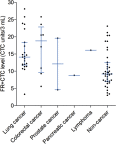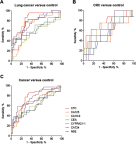The utility of folate receptor-positive circulating tumor cell in cancer diagnosis in the elderly population
- PMID: 31190982
- PMCID: PMC6511626
- DOI: 10.2147/CMAR.S184532
The utility of folate receptor-positive circulating tumor cell in cancer diagnosis in the elderly population
Abstract
Purpose: Cancer mortality is relatively high in the elderly population. Folate receptor-positive circulating tumor cell (FR+CTC) has proven an effective biomarker for diagnosis of lung cancer and bladder cancer and may be suitable for other cancer types accompanied with a high expression of FR. To date, the diagnostic efficiency of FR+CTC in the elderly population has not been systematically studied. Herein, we sought to investigate the utility of FR+CTC in cancer diagnosis in the elderly population and the influence of comorbidities on FR+CTC levels in such a population. Patients and methods: A total of 35 cancer patients (including 23 lung cancers, 8 colorectal cancers, and 4 other cancers) and 40 noncancer participants, aged between 80 and 110, were recruited in this study. Three milliliters of pretreatment peripheral blood was collected from each participant for FR+CTC analysis. Results: Compared to previous studies, the FR+CTC level was slightly higher in the elderly population (median FR+CTC levels in cancer patients versus noncancer participants were 14.3 versus 9.2 CTC U/3 mL, respectively, P=0.0002). With 10.0 CTC U/3 mL as the cut-off value, the sensitivity and specificity of FR+CTC were 85.7% and 65.0%, respectively. In combination with established serum tumor biomarkers, the diagnostic efficiency of FR+CTC further improved (sensitivity=87.9%, specificity=71.8%). Clinical factors including diabetes, cardiovascular diseases, respiratory diseases, cerebral infarction, and cardiac, liver, and kidney function were not associated with the FR+CTC level (P>0.05). Conclusion: In this exploratory study, we showed that FR+CTC is an effective biomarker for cancer diagnosis in the elderly population. The presence of comorbidities did not affect the diagnostic efficiency of FR+CTC.
Keywords: biomarker; cancer; circulating tumor cell; elderly; folate receptor.
Conflict of interest statement
The authors report no conflicts of interest in this work.
Figures



Similar articles
-
The value of folate receptor-positive circulating tumor cells in the diagnosis of lung cancer and its correlation with clinical characteristics.Clin Respir J. 2023 May;17(5):374-383. doi: 10.1111/crj.13601. Epub 2023 Mar 28. Clin Respir J. 2023. PMID: 36977421 Free PMC article.
-
Validation of the diagnostic efficiency of folate receptor-positive circulating tumor cells in lung cancers: a prospective observational study.Transl Cancer Res. 2019 Aug;8(4):1242-1248. doi: 10.21037/tcr.2019.07.10. Transl Cancer Res. 2019. PMID: 35116866 Free PMC article.
-
Folate-receptor-positive circulating tumor cells as an efficacious biomarker for the diagnosis of small pulmonary nodules.J Cancer Res Ther. 2018;14(7):1620-1626. doi: 10.4103/jcrt.JCRT_905_17. J Cancer Res Ther. 2018. PMID: 30589049
-
Role of the folate receptor in ovarian cancer treatment: evidence, mechanism, and clinical implications.Cancer Metastasis Rev. 2015 Mar;34(1):41-52. doi: 10.1007/s10555-014-9539-8. Cancer Metastasis Rev. 2015. PMID: 25564455 Review.
-
Circulating tumor cells: clinical validity and utility.Int J Clin Oncol. 2017 Jun;22(3):421-430. doi: 10.1007/s10147-017-1105-2. Epub 2017 Feb 25. Int J Clin Oncol. 2017. PMID: 28238187 Review.
Cited by
-
The value of folate receptor-positive circulating tumor cells in the diagnosis of lung cancer and its correlation with clinical characteristics.Clin Respir J. 2023 May;17(5):374-383. doi: 10.1111/crj.13601. Epub 2023 Mar 28. Clin Respir J. 2023. PMID: 36977421 Free PMC article.
-
A preliminary study of the clinical significance of folate receptor-positive circulating tumor cell in the management of hepatobiliary-pancreatic cancers.Transl Cancer Res. 2020 Nov;9(11):6700-6709. doi: 10.21037/tcr-20-2192. Transl Cancer Res. 2020. PMID: 35117280 Free PMC article.
-
[Research Advances in the Mechanism of Invasion and Metastasis of Circulating Tumor Cells in Lung Cancer].Zhongguo Fei Ai Za Zhi. 2020 Mar 20;23(3):189-195. doi: 10.3779/j.issn.1009-3419.2020.03.09. Epub 2020 Feb 27. Zhongguo Fei Ai Za Zhi. 2020. PMID: 32102136 Free PMC article. Review. Chinese.
-
The value of folate receptor-positive circulating tumour cells as a diagnostic biomarker for lung cancer: a systematic review and meta-analysis.J Int Med Res. 2023 Sep;51(9):3000605231199763. doi: 10.1177/03000605231199763. J Int Med Res. 2023. PMID: 37751487 Free PMC article.
-
BCAR1 plays critical roles in the formation and immunoevasion of invasive circulating tumor cells in lung adenocarcinoma.Int J Biol Sci. 2021 Jun 11;17(10):2461-2475. doi: 10.7150/ijbs.61790. eCollection 2021. Int J Biol Sci. 2021. PMID: 34326687 Free PMC article.
References
-
- Bolton WD, Rice DC, Correa AM, et al. Influence of age on choice of therapy and surgical outcomes in patients with nonsmall cell lung cancer. Am Surg. 2009;75:598–603. - PubMed
LinkOut - more resources
Full Text Sources

